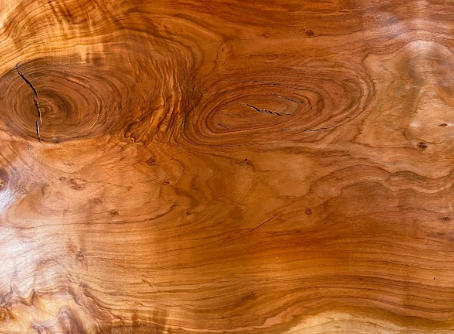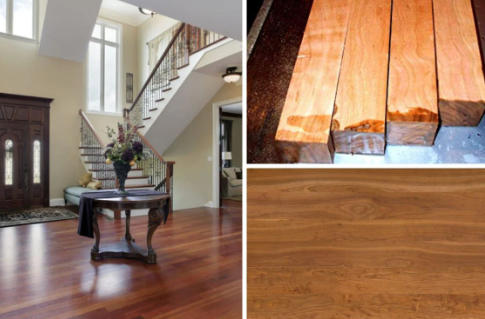










Content Menu
>> Cherry Wood's Botanical Identity
● Cherry Wood's Key Characteristics
>> Grain, Texture, and Natural Beauty
● Market Trends and Economic Importance
● Why Cherry Wood Remains a Favorite
>> Durability Suited for Fine Living
>> Environmental Responsibility
● How Cherry Compares to Other Woods
● Cherry Wood Care and Maintenance
● Cherry Wood in Contemporary Design
● Is Cherry Wood Worth the Investment?
>> 1. Why is cherry wood classified as a hardwood?
>> 2. How hard is cherry wood compared to other popular hardwoods?
>> 3. Does cherry wood change color over time?
>> 4. Is cherry wood resistant to scratches and dents?
>> 5. What are the main uses of cherry wood?
Cherry wood stands as a favorite in the world of fine woodworking and furniture, revered for its warm, rich color and adaptability. Its story extends beyond its beauty, encompassing unique botanical traits, market significance, and craftsmanship traditions. This article will thoroughly answer the question, “Is cherry wood hardwood?” by clarifying definitions, examining properties, comparing market trends, and offering guidance on cherry wood's use and maintenance.

Hardwoods are derived from angiosperm trees, typically broad-leaved deciduous species that lose their leaves annually. In contrast to softwoods, which come from coniferous evergreens, hardwoods like cherry, oak, and maple produce flowers and encased seeds. The scientific distinction does not depend solely on density or mechanical "hardness," but on cellular structure and botanical origin.[1][2]
The cherry tree belongs to the *Prunus* genus and the Rosaceae family. It is native primarily to North America, though several cherry species grow worldwide. Most cherry lumber is sourced from the American black cherry (*Prunus serotina*), an angiosperm—therefore, cherry is unequivocally a hardwood.[3][1]
Cherry wood is celebrated for its uniform, fine and straight grain, often accented by curly or wavy figures that add individuality to each piece. Occasional mineral streaks or gum pockets introduce additional charm. When freshly milled, the wood is a pale pinkish or golden brown, which matures to a deep, reddish-brown patina as it ages.[4][5][6][2]
- Density/Weight: Moderately dense, with a specific gravity around 0.5.[1]
- Janka Hardness: Ranges between 950 and 995 lbf—softer than maple or oak, harder than pine.[7][5][8][1]
- Workability: Smooth, predictable, and easy to work; ideal for intricate details or joinery.[5]
- Durability: Moderate resistance to wear, nicks, and dents, but softer than some other domestic hardwoods.[9][4]
- Rot Resistance: The heartwood is highly durable and resistant to decay, though not typically used for outdoor applications.[3]
| Property | Value |
|---|---|
| Janka Hardness | 950–995 lbf |
| Specific Gravity | 0.5 |
| Color (aged) | Reddish-brown, deep |
| Grain | Fine, straight |
| Stability | Good |
One of cherry wood's most prized qualities is its dramatic color transformation. Sunlight and oxidation darken the wood noticeably within months, deepening hues from pale to richly reddish-brown. This makes each piece uniquely beautiful—the patina cannot be replicated artificially.[7][5]
Cherry wood commands a premium in global markets for fine furniture and luxury interiors. The global cherry wood market was valued at $349 million in 2024, projected to grow to $370 million in 2025 and reach $480 million by 2031, reflecting a 4.8% CAGR. High demand in North America, Europe, and certain Asian markets is fueled by consumer appetite for luxury wood products, increasing home renovation, and a preference for warm natural finishes.[10][11]
Sustainability initiatives and forestry policy continue to influence supply and price trends. The push for certified, responsibly sourced cherry wood is shaping future demand, especially with stricter regulations and shifting global trade policy.[12][13][10]
No two pieces of cherry are exactly alike. The natural aging process guarantees that furniture and millwork become more beautiful over time—a quality highly valued among craftspeople and collectors.[2][4]
Although softer than maple or oak, cherry wood offers enough strength to withstand decades of household use. Its flexibility (moderate shock resistance) allows it to absorb impact without splintering, and the straight grain helps resist warping and shrinkage.[8][5][1]
Cherry is a woodworker's delight, cutting cleanly and accepting sandpaper, glue, fasteners, and finishes with ease. Its predictability makes it ideal for detailed joinery, curved moldings, turned objects, and hand-crafted furniture.[5][9]
- Handmade and factory furniture
- Premium cabinetry, including kitchens and bathrooms
- Flooring in low-traffic, formal, or residential areas
- Musical instrument parts (backs, sides, and necks of stringed instruments)
- Interior architectural trim, doors, and paneling
- Decorative veneer and marquetry
- Carvings and specialty crafts
North American cherry is widely available and usually harvested following sustainable forestry practices. Certification adds to its desirability for eco-conscious buyers.[6][10][12]

| Wood | Hardness (Janka) | Distinctive Features | Common Uses |
|---|---|---|---|
| Cherry | 950–995 lbf | Warm, reddish hue; ages well | Furniture, cabinetry |
| Maple | 1,450 lbf | Dense, pale, durable | Flooring, furniture |
| Red Oak | 1,290 lbf | Coarse open grain, strong | Flooring, cabinetry |
| Walnut | 1,010 lbf | Deep brown, stable | Furniture, veneers |
| Pine* | ~420 lbf | Soft, light, easy to work | Shelving, trim |
Note: Pine is classed as a softwood.
While cherry is not the hardest hardwood, it exceeds all softwoods in durability, and offers a unique blend of beauty and workability unrivaled in its class.[14][9]
Black cherry flourishes across the eastern United States. Pennsylvania, Virginia, West Virginia, and New York are major producers, but the species adapts to a wide range of climates and soil types. Cherry's widespread distribution and the adoption of certified forestry make it a sustainable choice when purchased from reputable sources. European buyers increasingly require Forest Stewardship Council (FSC) or similar certification.[10][1]
The global cherry wood market is poised for stable growth through the 2020s. Aesthetic trends, such as the popularity of natural, warm interiors and “Japandi” style, support continued demand, alongside high-end furniture, cabinetry, and luxury home renovation. At the same time, pricing can fluctuate due to supply-side issues, tariffs, labor shortages, and environmental regulations.[11][13][6][10]
Proper care helps cherry wood realize its full potential for beauty and durability:
- Finishing: Cherry takes most clear finishes beautifully. Natural oils (tung, linseed) or modern oil-wax blends enhance the depth of its grain and patina.[15][16]
- Staining: Cherry can blotch with stains. If color is desired, pre-stain conditioners or gel stains help minimize uneven absorption.[17][18][15]
- Sanding and Polishing: Use progressively finer grits (ending at 220 or higher) for a smooth finish. Clean thoroughly between sanding stages and before applying finish.[19][17]
- Sunlight: Direct sun leads to rapid darkening. Rotate objects on cherry furniture regularly to avoid spot or uneven color development.
- Climate Control: Maintain stable humidity to prevent shrinking, warping, or cracking.
American cherry floors can be sanded and refinished repeatedly. Using an orbital sander and appropriate grit progression achieves a flawless surface. For stain application, pre-stain conditioners and gel stains are recommended to avoid blotchiness. Natural finishes are popular for showcasing cherry's unique, deepening hues.[17][15]
Cherry wood complements various décor styles, from classic Shaker and Mission styles to modern minimalist aesthetics. Designers favor cherry for its ability to add warmth, sophistication, and a touch of luxury to interiors, whether in built-in units or as accent pieces.
- Pairing cherry with lighter woods or painted cabinetry for contrast
- Using wide, live-edge cherry slabs for dining tables or countertops
- Incorporating cherry details, like floating shelves or stair treads, in open-concept spaces
Cherry wood is often more expensive than domestic oak or imported beech due to supply and high demand for premium projects. Its value, however, is justified by its longevity, environmental responsibility, and timeless aesthetic. With proper care, cherry pieces can be cherished heirlooms, increasing in beauty as they mature in the home.[4][5]
Cherry wood is, by every scientific and technical measure, a hardwood. Its distinctive blend of warmth, graceful aging, moderate hardness, and unmatched workability has earned it a place of distinction among both woodworkers and consumers. Market trends point to sustained demand, especially for responsibly sourced cherry, as premium interiors and eco-conscious buyers elevate its desirability. Whether for fine furniture, cabinetry, or statement décor, cherry wood's investment rewards users with a material that grows ever more elegant with time.

Cherry wood comes from angiosperm trees such as the American black cherry, meeting the strict botanical definition of hardwood regardless of perceived softness.[3][1]
Cherry rates 950–995 lbf on the Janka scale—softer than maple or oak, similar to walnut, yet much harder and tougher than softwoods like pine.[8][4][5]
Yes, cherry wood darkens quickly when exposed to air and sunlight, developing a rich, reddish-brown patina that is highly prized in furniture making.[6][7][5]
Cherry is moderately resistant but can scratch or dent more easily than harder hardwoods; careful placement and protective pads help preserve appearance.[9][4][8]
Cherry wood excels in fine furniture, cabinetry, decorative millwork, musical instruments, and as a premium material for luxury flooring and interior finishes.[20][2][5]
[1](https://www.gutchess.com/hardwood-species-highlight-cherry-wood/)
[2](https://vermontwoodsstudios.com/pages/cherry-wood)
[3](https://www.wood-database.com/black-cherry/)
[4](https://www.dutchcrafters.com/blog/cherry-vs-oak-for-wood-furniture/)
[5](https://www.tyfinefurniture.com/blogs/blog/what-is-cherry-wood)
[6](https://glamorwood.com/types-of-wood/hardwood/black-cherry-wood/)
[7](https://glamorwood.com/types-of-wood/cherry-wood/)
[8](https://www.osbornewood.com/blog/faq/cherry-vs-alder-wood-which-is-right-for-your-project)
[9](https://battlebornwoodshop.com/blogs/news/behind-the-grain-the-unique-characteristics-of-cherry-wood)
[10](https://www.intelmarketresearch.com/blog/300/cherry-wood-market)
[11](https://www.archivemarketresearch.com/reports/cherry-wood-412747)
[12](https://www.linkedin.com/pulse/global-cherry-wood-market-valued-xx-billion-2025-u8pve)
[13](https://www.linkedin.com/pulse/top-cherry-wood-companies-how-compare-them-2025-7v6me)
[14](https://butcherblockco.com/hardwood-species-comparison)
[15](https://www.vanvleetwoodworking.com/blog/2018/3/18/finishing-cherry-wood-how-to)
[16](https://www.woodworkerssource.com/blog/woodworking-101/tips-tricks/5-simple-cherry-wood-finishes/)
[17](https://romerohardwoodfloor.com/refinishing-american-cherry-floors/)
[18](https://www.popularwoodworking.com/finishing/tips-for-finishing-cherry/)
[19](https://www.woodcraft.com/blogs/sanding-finishing/finishing-cherry-at-the-lohr-woodworking-school)
[20](https://northcastlehw.com/blogs/wood/how-to-use-cherry-lumber-for-woodworking)
[21](https://www.youtube.com/watch?v=In4xbmq3Kwk)
[22](https://selecthardwoodslumber.churchandchurchlumber.com/blog/2025-hardwood-market-outlook-pricing-trends-and-forecasts)